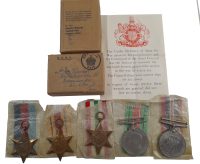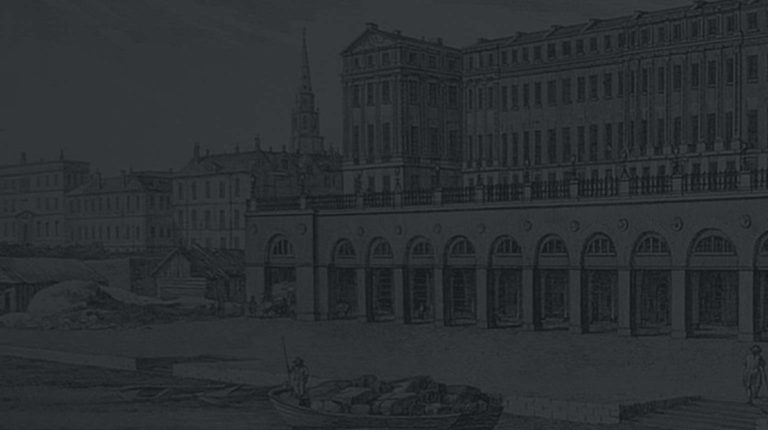Description
A World War Two Sicily Casualty Group of 5 attributed to Rifleman Horace Joseph Savage, 1st Battalion The London Irish, Royal Ulster Rifles, who was Killed in Action on the 17th July 1943 in the attack at Fosso Bottaceto, Sicily comprising, 1939-45 Star, Africa Star, Italy Star, 1939-45 Defence Medal, 1939-45 War Medal, all unnamed as issued, toned very fine.
Attack on Fosso Bottaceto
An attack on a brigade scale through the bridgehead which had already been forced over the Gornalunga River near the Primosole Bridge had been planned. Its direction was northwards towards Catania to the line of a ditch known as the Fosso Bottaceto. That afternoon some of the battalion, including the Mortar Platoon under the command of Captain D Gibson had their first taste of shell-fire when just south of the bridge. A hasty dive for cover was followed by a quick dash over the bridge, and the mortar carriers gathered in a sunken road on the north side. It was aptly named Dead Man’s Gulch on account of the large number of dead German paratroopers, and some of our own fellows, too, who lay along it.
The brigade attack was by night on July 17, with the London Irish on the left of the thrust, the London Scottish on the right, and with the 10th Royal Berkshire Regiment in reserve. Support was to be given by the whole of the divisional artillery plus a field regiment, a medium regiment, and two regiments of self-propelled Priest guns. In addition the Cheshire machine-gunners were to fire in support, and the light “ack-ack” to fire directional tracer on the flanks of the attack. The objective given was the Fosso Bottaceto, and thereafter it was expected that either the reserve battalion or one from another brigade would pass through. The battalion’s plan of attack put ‘A’ Company on the right, ‘C’ Company in the centre, ‘D’ Company on the left, and ‘B’ Company in reserve; a mortar detachment in a carrier in support of each forward company and three carriers in reserve.
The assembly area was close vineyard, giving only low cover from view. It had seen considerable fighting earlier and was strewn with dead and quantities of equipment and smashed vehicles. The movement of any wheeled vehicle was extremely difficult, and all trucks were virtually confined to one narrow track in and out. Prior to the attack difficulty was experienced in getting ammunition and tools to the companies, but this task eventually was accomplished. About thirty minutes before zero hour information came that as it was believed that the enemy had gone—this was based on the report of an armoured reconnaissance by the Royal Tank Regiment and carriers of the London Scottish and the Royal Berkshires—the attack would now be silent, and that the preliminary artillery programme would be laid on only if called for. In any case the full barrage would come down on the German positions fifteen minutes before the infantry were timed to arrive on them.
There was hardly time to get this information to the companies who were out at the start-line. At 2200 hours, zero hour, it became apparent that the new orders for a silent attack had not reached all concerned, for the light “ack-ack” and the machine-gunners began to fire on their tasks. The enemy did not reply. The London Irish had moved up in daylight through vineyards and remained under cover. The start-line was one thousand five hundred yards beyond, and to reach that they clambered through German wire a foot high. When the order came to advance they moved forward steadily with bayonets fixed. The ground was flat, hard, and apart from a few shallow ditches was devoid of cover. The first bound was a long narrow wall or bank of earth and stones protected by barbed wire. The leading companies had covered about two thousand yards and were four hundred yards from this wall when the supporting barrage opened. When it lifted they went in to the attack. The wire was cut and they reached the bank and clambered over. The enemy had not manned it, hut as the London Irish passed over they saw another bank, much higher, thirty yards ahead. As they approached it the Germans opened fire. The Irish got to the hank, hurled themselves up and over it, and slithered down the other side. Here they found themselves in a wide gully with yet a higher bank in front. That was their main objective, the Fosso Bottaceto. As they made towards it the enemy opened up with machine-guns, mortars, and automatics. They were so close that oil flares were thrown by the enemy and landed among the leading troops.
Along the gully from left and right German machine-guns fired deadly bursts about knee-high. Mortar bombs burst and shells came from two light-calibre guns hidden away on the flanks. Suddenly a great mass of flame went up. An oil-storage tank just behind the German lines was hit and the whole area was illuminated as by day. The London Irishmen were caught in the glare and some were killed at short range. The crossfire spattered against the sides of the carriers and the mortars were lifted out and mounted behind them, the only cover available. During a vital half-hour two carriers received direct hits, one of which wounded all three mortar crew. The others mounted their mortar in a ditch and fired on.
Despite the fierce and perhaps unexpected German resistance, the men of ‘A’ Company on the right, led by Major Cantopher and Captain MD Ryan, clambered up and down the banks and reached the main ditch, the Fosso Bottaceto. In the centre, ‘C’ Company reached their objective, and inspired by the example of their Commander, Major Brooks, engaged the enemy hand-to-hand among the pill-boxes and earthworks. ‘D’ Company on the left, under Captain Sir James Henry and Captain John Strick, pushed on doggedly but were pinned down by the fierce reaction of a wide-awake enemy. Each company had lost valued officers. Lieutenant Power was killed leading his platoon, Lieutenant Orr and Lieutenant Coghlin fell as, with great gallantry, they had pressed forward under a hail of fire.
Most of the officers and the CSM of ‘A’ Company became casualties and Sergeant John Madigan, despite a wound in the arm, tackled a pill-box with one of his corporals. Indifferent to personal danger, he found his Company Commander lying wounded and he took over from him. Under his direction the company were organised once again and the fight went on. As Lieutenant AE Crampton took his men forward a bullet passed through the rim of his steel helmet and grazed his scalp. The officer was momentarily stunned, but he recovered and went on.
With their forward troops holding precariously to their gains, the situation was rapidly assessed at battalion headquarters. The intense enemy fire from the right was due to the fact that the London Scottish had been unexpectedly and heavily opposed from the wood on their front which earlier had been reported empty. This prevented adequate support being given to the London Irish from that direction and their right flank became exposed. During the confusion of the battle a party of London Scots managed to get through and joined Major Cantopher and his men. By midnight the leading platoons were back on the bank one hundred yards from the Fosso Bottaceto. This gave some cover from the crossfire, and all ranks were calm and steady. Stretcher-bearers moved fearlessly over the ground, tending and evacuating the wounded. One of them, Piper Thomas Brightman, who had been hit in the leg himself, moved about calmly and efficiently and tended fifteen wounded men who were carried to the aid-post in the rear.
Support from the gunners and the mortars enabled the London Irish to hold tight and maintain their positions, precarious though they were with both flanks open and a well-armed and well-placed enemy in front. For two hours attempts were made to find out from brigade what was the exact position of the London Scottish. That proved impossible by wireless, and as no information was forthcoming, Lieutenant S Sharp, the Intelligence Officer, made the long journey back to find out. The situation was still confused and it was obvious that the Scots had been unable to reach their target, but just how they were placed was very obscure.
A plan for a battalion from the reserve brigade, the Green Howards, to move through the rear of the London Irish and to endeavour to widen the bridgehead was put into operation at 0100 hours. After some further confused fighting in the dark, it became evident that this attack, too, had not succeeded, and the Green Howards withdrew to their original position. The London Irish were thus in a predicament. The forward companies had a hold on the German defences, but any move to advance over the bank was met by heavy fire from the enemy’s second and principal defence line. It was realised that no further progress could be made without considerable additional support and the silencing, in particular, of the German flanking fire. If the London Irish maintained their position they would find themselves at daylight on a clearly defined bank, very close to the enemy, with both flanks exposed, and with practically no cover from the German machine-guns, mortars, and grenades. The forward companies had suffered rather heavy casualties and ammunition was running short. More could not be sent up before daylight because the trucks could not get across the irrigation ditches, and five carriers had already been knocked out or stranded in the attempt.
The situation was discussed with the Brigade Commander, and it was decided that the London Irish should withdraw by daylight. That was unpleasant, but it was the only sensible thing to do. ‘B’ Company, under Captain HCS Lofting, moved into position to cover the forward companies and with support by the mortars the withdrawal was carried out in good order and with no further loss. The London Irish soon reorganised on new lines a little to the rear, and then daylight came.
Rifleman Horace Savage is reported Killed in Action In the Middle East Expeditionary Forces – Sicily, Casualty List of July 1943, Horace was the son of Charles D. Savage and Annie M. Savage of Drumcondra, Irish Republic, his body was not located after the War and he is commemorated on Panel 11 of the Cassino Memorial, Italy.
Sold with original Condolence Bestowal slip named (Rfn H.J. Savage) and Original Card Box of issue addressed to (Mrs A. M Savage 34 Susanville Road, Drumcondra Dublin Eire.)
Copy Casualty List entry and Commonwealth War Graves information.


